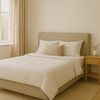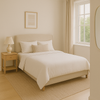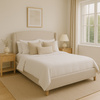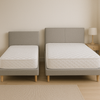Luxury on a Budget: How to Create a Premium-Looking Bedroom Without Overspending
- by Mariam Labadze
Quick Answer
Creating luxurious bedroom aesthetics on limited budgets requires strategic investments and clever styling: prioritize one quality anchor piece (typically the bed frame or headboard, £400-£800) establishing premium tone, then surround with budget-conscious elements. Layer affordable bedding (£80-£150 for complete sets) in neutral colors with varied textures creating depth, add inexpensive luxury touches through velvet cushions (£15-£25 each), faux fur throws (£30-£50), and strategic lighting including dimmer switches (£15-£30) and budget statement fixtures (£50-£150). Transform existing furniture through paint (£20-£40 per piece), new hardware (£3-£8 per handle), and creative staging rather than replacing everything. Declutter ruthlessly—luxury equals spaciousness and simplicity rather than crowded abundance. DIY upholstered headboards (£80-£150 materials), peel-and-stick wallpaper accent walls (£40-£80), and thrifted vintage pieces (£20-£100) deliver high-end looks at fraction of retail luxury costs.
The Strategic Investment Approach
Identifying Your Anchor Piece – Luxury bedrooms benefit from one genuinely quality element anchoring the space and establishing premium expectations that surrounding budget pieces then support. This focal point typically proves the bed itself—the room's natural center and primary furniture piece warranting the largest portion of limited budgets.
A quality upholstered bed frame in neutral fabric costing £400-£800 creates more luxurious impression than £400 spent across multiple mediocre furniture pieces that collectively read as budget despite equivalent total investment. The singular focus creates perceived value exceeding distributed spending across items individually signaling compromise.
Consider where guests' and your own attention naturally focuses. Beds dominate bedrooms visually and functionally, making them logical investment priorities. However, in rooms with architectural features—beautiful windows, period moldings, interesting ceiling heights—these existing assets might warrant investment in treatments or lighting emphasizing inherent luxury that furniture purchases cannot replicate.
Where to Economize – Secondary furniture including nightstands, dressers, and seating can safely occupy budget tiers when styled thoughtfully. Simple designs in neutral finishes prove virtually indistinguishable from premium alternatives when properly accessorized and maintained, making these areas ideal for savings that redeploy toward anchor piece quality.
Bedroom lighting fixtures, whilst important, need not carry designer price tags. Budget retailers offer statement pendants, elegant table lamps, and attractive flush-mounts at £40-£150 that read as considerably more expensive when properly scaled and positioned within rooms.
Window treatments represent another economical opportunity. Simple roller blinds or budget curtain panels in quality neutral fabrics create clean, sophisticated backgrounds costing fraction of custom treatments whilst delivering nearly equivalent aesthetic impact when properly hung and maintained.
Bedding Layering: The Instant Luxury Trick
Foundation Layers – Start with quality fitted sheets in neutral colors—white, cream, soft grey, or pale blue. Egyptian or long-staple cotton in 200+ thread count provides luxurious feel without premium pricing—expect £25-£45 for quality fitted and flat sheet sets during sales at mainstream retailers.
Thread count marketing often misleads, but 200-400 thread count in quality long-staple cotton feels more luxurious than 800+ thread count in shorter-staple varieties where excessive threads create heavy, less breathable fabrics despite impressive numbers suggesting otherwise.
White or neutral foundations provide versatility accommodating seasonal accent changes without requiring complete bedding replacement—transform room moods through cushions and throws rather than expensive complete bedding set purchases each season.
The Layering Formula – Premium hotel aesthetics come from layering multiple elements creating dimensional richness:
-
Fitted sheet – Quality neutral foundation (£15-£25)
-
Flat sheet or lightweight blanket – Adds texture and warmth (£15-£30)
-
Duvet with quality cover – Main visual element (£40-£80 for cover and insert)
-
Decorative throw – Folded at foot or draped casually (£25-£50)
-
Cushions – 4-6 in varying sizes and textures (£60-£120 total)
This complete layered bed costs £155-£305 total yet creates visual richness suggesting considerably higher investment through thoughtful composition rather than individual item expense.
Texture Over Pattern – Luxury reads through varied textures—smooth cotton, nubby linen, plush velvet, soft faux fur—rather than busy patterns that date quickly and limit décor flexibility. Mixing textures in tonal color schemes creates sophisticated depth that patterned bedding struggles achieving without appearing busy or juvenile.
Velvet cushions (£15-£25 each at budget retailers) instantly elevate beds through tactile richness and subtle sheen that catches light beautifully. Faux fur or cable knit throws (£30-£50) add dimensional interest and cozy luxury that flat cotton alternatives cannot replicate regardless of thread count.
Paint and Color Psychology
The Power of Neutrals – Luxury interiors typically embrace sophisticated neutral palettes—soft whites, warm greys, gentle beiges, muted blues—creating serene, spacious impressions that bold colors rarely achieve. Neutrals photograph beautifully, never feel dated, and provide versatile backgrounds accommodating accent changes without repainting.
Paint represents the highest-impact, lowest-cost transformation available—£30-£50 in quality paint completely changes room character while requiring only time investment rather than substantial financial outlay. This exceptional value-to-impact ratio makes painting the first consideration when budget-conscious luxury proves the goal.
Feature Wall Impact – Rather than painting entire rooms in premium colors, create accent walls using slightly deeper or richer tones than surrounding walls. This technique adds visual interest and architectural definition whilst limiting expensive specialty paint to single walls rather than entire room coverage.
The wall behind beds naturally suits accent treatment—it receives primary focus whilst occupying relatively small surface area compared to full room painting. Consider soft charcoal, warm taupe, or muted sage creating subtle richness without overwhelming brightness that lighter tones provide.
Ceiling Considerations – The often-overlooked "fifth wall" dramatically affects room perception. Painting ceilings in colors slightly lighter than walls creates height illusion, whilst soft whites or warm creams add subtle richness over stark bright white that feels institutional rather than luxurious.
In rooms with beautiful ceiling heights (2.7m+), consider subtle ceiling color adding coziness, whilst standard-height rooms benefit from keeping ceilings light maintaining spaciousness that colored ceilings might compromise.
Furniture Transformations and Budget Finds
Paint and Hardware Updates – Existing furniture often proves perfectly functional but aesthetically tired. Quality chalk paint (£20-£30 per liter, covering 8-10m²) transforms dated pieces without extensive preparation, whilst new drawer pulls and handles (£3-£8 each) create surprisingly substantial visual updates.
Choose hardware finishes coordinating with other room metals—brushed brass for warmth, matte black for contemporary edge, brushed nickel for cool sophistication. Consistent metal finishes throughout rooms create cohesion suggesting intentional design rather than accumulated random pieces.
Sand lightly, apply two coats of chalk paint, then seal with wax or polyurethane creating durable finishes rivaling factory applications. This DIY approach costs £40-£80 per furniture piece versus £200-£400 for equivalent new purchases—dramatic savings whilst achieving comparable aesthetic results.
Thrift and Vintage Hunting – Second-hand furniture offers genuine quality at fraction of retail pricing. Solid wood dressers from 1960s-80s prove far superior to modern particleboard alternatives whilst costing less—£50-£150 at charity shops or online marketplaces buys substantial furniture requiring only cosmetic updating rather than structural repair.
Look beyond current finishes imagining potential. Ugly varnished pine transforms beautifully through painting, whilst dated brass hardware swaps easily for contemporary alternatives. The underlying construction quality matters most—dovetail joinery, solid wood construction, smooth drawer operation all indicate furniture worth updating rather than bypassing for cheaper new alternatives.
Strategic Flat-Pack – Budget retailers offer acceptable nightstands, simple shelving, and basic storage at £40-£100 that serve perfectly adequately when styled thoughtfully. The key involves selecting simple designs in neutral colors avoiding trendy details that date quickly or cheap embellishments that signal budget origins obviously.
Upgrade flat-pack pieces through hardware swaps, paint, or creative styling making generic items feel curated. A £40 basic nightstand with £8 upgraded handles and £5 paint application competes visually with £150 retail alternatives whilst costing third the price.
Lighting: The Luxury Essential
Layered Lighting Design – Luxury bedrooms feature multiple light sources at varying heights creating dimensional illumination impossible from single overhead fixtures. This layering costs minimally yet dramatically improves ambiance and functionality:
Ambient lighting – Overall room illumination through ceiling fixtures (£50-£150 for attractive budget options) Task lighting – Bedside reading lamps providing focused light (£30-£60 each) Accent lighting – Decorative elements including string lights or LED strips (£15-£40)
This complete lighting scheme costs £140-£350 total yet creates layered sophistication that single fixture approaches cannot achieve regardless of individual fixture expense.
Dimmer Switch Magic – Installing dimmer switches (£15-£30 including installation if DIY-capable, £60-£100 with electrician) transforms room ambiance through adjustable lighting intensity. This relatively minimal investment provides luxury hotel flexibility adapting lighting to activities and moods rather than accepting fixed brightness regardless of needs.
Dimmers work with both overhead fixtures and plug-in lamps (using smart plugs or compatible bulbs), allowing comprehensive lighting control throughout rooms without extensive rewiring or expensive smart home systems.
Statement vs. Function – Prioritize visual impact in prominent positions while accepting purely functional fixtures where aesthetics matter less. Beautiful ceiling fixtures or table lamps in primary sightlines create luxury impressions, whilst closet or drawer lighting can safely use basic functional options that practical necessity demands but design impact doesn't require.
Budget £100-£150 for one showpiece light fixture establishing design direction, then surround with £30-£60 supporting fixtures in complementary styles. This focused approach creates more cohesive luxury impression than evenly distributing £200 across multiple mediocre fixtures lacking individual distinction.
DIY Luxury Touches
Upholstered Headboard Project – Custom upholstered headboards cost £400-£800 retail but DIY versions achieve similar results for £80-£150 in materials:
-
Plywood cut to size (£25-£40)
-
High-density foam padding (£30-£50)
-
Fabric (£25-£40 for 2-3 meters of quality material)
-
Staple gun and staples (£15-£20 if not owned)
The process involves cutting plywood to desired dimensions, attaching foam with spray adhesive, stretching fabric over foam, and stapling to rear. Wall-mount using French cleats or brackets creating custom luxury at fraction of retail pricing.
Choose neutral fabrics initially—linen, velvet, or textured weaves in greys, creams, or soft blues. The neutral investment provides longevity whilst accent colors change through easily-replaced cushions and throws.
Peel-and-Stick Transformations – Removable wallpaper creates accent walls or feature areas costing £40-£80 for single wall coverage whilst requiring no special skills beyond careful measuring and application. The temporary nature suits rental properties where permanent alterations prove impossible.
Subtle textures, geometric patterns, or sophisticated florals add dimension and personality without overwhelming rooms or limiting future décor flexibility. Apply behind beds creating instant architectural interest that permanent wallpaper provides without commitment or expense.
Crown Molding Impact – Lightweight polyurethane crown molding (£15-£30 per 2.4m length) installs with miter saw and adhesive, adding architectural detail suggesting period character or custom construction. Four walls in average bedroom require £60-£120 in materials plus adhesive—modest investment for substantial perceived value addition.
Paint molding to match ceilings creating subtle definition, or in accent colors creating bolder statements. The dimensional shadow lines add depth and sophistication that flat wall-ceiling junctions lack regardless of paint colors selected.
Decluttering and Space Management
The Luxury of Space – True luxury equals spaciousness and simplicity rather than abundant possessions crowding surfaces and floors. Ruthlessly declutter removing anything not genuinely useful or beautiful, creating breathing room that cramped accumulation prevents regardless of individual item quality.
Clear nightstand surfaces except essential items (lamp, perhaps one book or small plant). Hide charging cables, remove excess decorative objects, and resist the urge filling every surface. The negative space itself reads as luxury—suggesting you possess editing capability and spatial confidence that clutter contradicts.
Smart Storage Solutions – Invest in attractive storage containing necessary items invisibly:
-
Under-bed storage boxes (£15-£30) hiding seasonal clothing or extra bedding
-
Attractive baskets (£20-£40) corralling items stylishly
-
Floating shelves (£15-£30) displaying curated objects whilst clearing floor space
-
Over-door organizers (£10-£20) maximizing vertical storage where horizontal space proves limited
The goal involves containing necessities whilst maintaining visual simplicity that luxury requires. Everything owned needn't display simultaneously—rotation through season or mood keeps rooms feeling fresh whilst maintaining the clean aesthetic that luxury demands.
The Capsule Bedroom Concept – Pare furniture to essentials plus one or two beautiful objects. Resist filling rooms simply because space exists—intentional emptiness proves more luxurious than crowded abundance regardless of individual item quality.
Consider whether every furniture piece earns its spatial footprint. The chair in corners accumulating clothing doesn't contribute to luxury regardless of its theoretical purpose. Remove it, designate proper clothing storage, and appreciate the spatial luxury that removal provides.
At Moorcroft Beds, we believe luxury should prove accessible regardless of budget constraints. Our range includes quality beds at various price points—including options under £500 that anchor luxury bedrooms beautifully—whilst our styling expertise helps customers maximizing impact from limited budgets through strategic choices creating premium aesthetics without premium pricing.




